Summary of the Blind Spot Monitor
The Blind Spot Monitor is a system that has 2 functions;
- The Blind Spot Monitor function
Assists the driver in making the decision when changing lanes
- The Rear Cross Traffic Alert function
Assists the driver when backing up
These functions use same sensors.
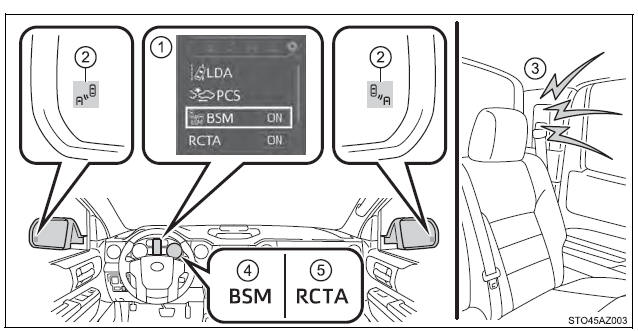
- Multi-information display
Turning the BSM function/RCTA function on/off.
- Outside rear view mirror indicators
Blind Spot Monitor function:
When a vehicle is detected in a blind spot of the outside rear view mirrors
or approaching rapidly from behind into a blind spot, the outside
rear view mirror indicator on the detected side will illuminate. If the turn
signal lever is operated toward the detected side, the outside rear view
mirror indicator will flash.
Rear Cross Traffic Alert function:
When a vehicle approaching from the right or left at the rear of the vehicle
is detected, both outside rear view mirror indicators will flash.
- Rear Cross Traffic Alert buzzer (Rear Cross Traffic Alert function
only)
When a vehicle approaching from the right or left rear of the vehicle is
detected, a buzzer sounds from behind the left-hand rear pillar.
- "BSM" indicator
When the BSM function is turned on, the indicator illuminates.
- "RCTA" indicator
When the RCTA function is turned on, the indicator illuminates.
Turning the BSM function/RCTA function on/off
The BSM (Blind Spot Monitor) function and RCTA (Rear Cross Traffic
Alert) function can be enabled/disabled on the multi-information display
as following:
1. Press " " or " " or " "
of meter control switches and select "
of meter control switches and select  . .
2. Press " " or " " or " "
of meter control switches and select "BSM" or
"RCTA", and press "
of meter control switches and select "BSM" or
"RCTA", and press  to select the
desired setting (on/off). to select the
desired setting (on/off).
Changing the BSM indicator brightness
The BSM (Blind Spot Monitor) outside rear view mirror indicators
brightness can be changed on the multi-information display as following:
1. Press " " or " " or " "
of meter control switches and select "
of meter control switches and select  . .
2. Press " " or " " or " "
of meter control switches and select "Vehicle
Settings", and then press "
of meter control switches and select "Vehicle
Settings", and then press  . .
3. Press " " or " " or " "
of meter control switches and select "BSM
Brightness", and then press "
of meter control switches and select "BSM
Brightness", and then press  to
select the desired setting
(bright/dim). to
select the desired setting
(bright/dim).
Changing the Rear Cross Traffic Alert warning buzzer volume
1. Press " " or " " or " "
of meter control switches and select "
of meter control switches and select  . .
2. Press " " or " " or " "
of meter control switches and select "Vehicle
Settings", and then press "
of meter control switches and select "Vehicle
Settings", and then press  . .
3. Press " " or " " or " "
of meter control switches and select "RCTA Volume",
and then press "
of meter control switches and select "RCTA Volume",
and then press  to select the
desired setting. to select the
desired setting.
The buzzer volume changes with each  press .
press .
■The outside rear view mirror indicators visibility
When under strong sunlight, the outside rear view mirror indicator may be
difficult
to see.
■Rear Cross Traffic Alert buzzer hearing
Rear Cross Traffic Alert function may be difficult to hear over noises such
as
high audio volume.
■When there is a malfunction in the Blind Spot Monitor system
If a system malfunction is detected due to any of the following reasons,
warning
messages will be displayed
- There is a malfunction with the sensors
- The sensors have become dirty
- The outside temperature is extremely high or low
- The sensor voltage has become abnormal
■Certification for the Blind Spot Monitor system
For vehicles sold in the U.S.A.
FCC ID: OAYSRR3A
This device complies with part 15 of the FCC Rules. Operation is subject to
the following three conditions:
(1) This device may not cause harmful interference, and
(2) this device must accept any interference received, including interference
that may cause undesired operation.
FCC Warning
Changes or modifications not expressly approved by the party responsible for
compliance could void the user's authority to operate the equipment.
For vehicles sold in Canada
Applicable law: Canada 310
This device complies with Industry Canada licence-exempt RSS standard(s).
Operation is subject to the following two conditions: (1) this device may not
cause interference, and (2) this device must accept any interference, including
interference that may cause undesired operation of the device.
Frequency bands: 24.05 - 24.25 GHz
Output power: less than 20 milliwatts
| WARNING ■Handling the radar sensor
One Blind Spot Monitor sensor installed inside the left and right side
of the
vehicle rear bumper respectively. Observe the following to ensure the
Blind
Spot Monitor system can function correctly.
- Keep the sensor and its surrounding
area on the bumper clean at all times.
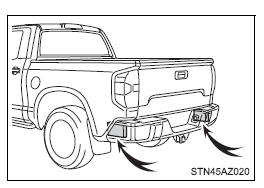
- Do not subject the sensor or surrounding area on the bumper to a
strong
impact. If the sensor moves even slightly off position, the system
may malfunction
and vehicles that enter the detection area may not be detected. If
the sensor or surrounding area is subject to a strong impact, always
have
the area inspected by your Toyota dealer.
- Do not disassemble the sensor.
- Do not attach accessories or stickers to the sensor or
surrounding area on
the bumper.
- Do not modify the sensor or surrounding area on the bumper.
- Do not paint the rear bumper any color other than an official
Toyota color.
|
The Blind Spot Monitor function
The Blind Spot Monitor function uses radar sensors to detect
vehicles
that are traveling in an adjacent lane in the area that is not
reflected in
the outside rear view mirror (the blind spot), and advises the
driver of
the vehicles existence via the outside rear view mirror indicator.
The Blind Spot Monitor function detection areas
The areas that vehicles can be detected in are outlined below.
The range of the detection area
extends to:
- Approximately 11.5 ft. (3.5 m)
from the side of the vehicle
The first 1.6 ft. (0.5 m) from the
side of the vehicle is not in the
detection area
- Approximately 9.8 ft. (3 m) from
the rear bumper
- Approximately 3.3 ft. (1 m) forward
of the rear bumper
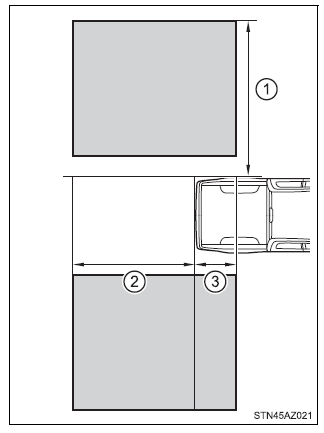
| WARNING ■Cautions regarding the use of the
system
The driver is solely responsible for safe driving. Always
drive safely, taking
care to observe your surroundings.
The Blind Spot Monitor function is a supplementary function
which alerts the
driver that a vehicle is present in the blind spot. Do not
overly rely on the
Blind Spot Monitor function. The function cannot judge if it
is safe to change
lanes, therefore over reliance could cause an accident
resulting in death or
serious injury.
According to conditions, the system may not function
correctly. Therefore
the driver's own visual confirmation of safety is necessary. |
■The Blind Spot Monitor function is operational when
- The BSM function is set to on.
- Vehicle speed is greater than approximately 25 mph (40
km/h).
■The Blind Spot Monitor function will detect a vehicle when
- A vehicle in an adjacent lane overtakes the vehicle.
- Another vehicle enters the detection area when it changes
lanes.
- You overtake a vehicle in adjacent lane.
■Conditions under which the Blind Spot Monitor function will
not detect a
vehicle
The Blind Spot Monitor function is not designed to detect the
following types
of vehicles and/or objects:
- Small motorcycles, bicycles, pedestrians, etc.*
- Vehicles traveling in the opposite direction
- Guardrails, walls, signs, parked vehicles and similar
stationary objects*
- Following vehicles that are in the same lane*
- Vehicles driving 2 lanes across from your vehicle*
- Vehicles which are being overtaken rapidly by your vehicle.
*: Depending on conditions, detection of a vehicle and/or object
may occur
■Conditions under which the Blind Spot Monitor function may
not function
correctly
- The Blind Spot Monitor function may not detect vehicles
correctly in the following
conditions:
- During bad weather such as heavy rain, fog, snow, etc.
- When ice or mud, etc., is attached to the rear bumper
- When driving on a road surface that is wet due to rain,
standing water,
etc.
- When there is a significant difference in speed between
your vehicle and
the vehicle that enters the detection area
- When a vehicle is in the detection area from a stop and
remains in the
detection area as your vehicle accelerates
- When driving up or down consecutive steep inclines, such
as hills, a dip
in the road, etc.
- When multiple vehicles approach with only a small gap
between each
vehicle
- When vehicle lanes are wide, and the vehicle in the next
lane is too far
away from your vehicle
- When the vehicle that enters the detection area is
traveling at about the
same speed as your vehicle
- When towing anything such as trailer, boat, etc.
- When there is a significant difference in height between
your vehicle and
the vehicle that enters the detection area
- Directly after the BSM function is set to on
- When towing a trailer
- When items such as a bicycle carrier are installed on
the rear of the vehicle
- Instances of the Blind Spot Monitor function unnecessarily
detecting a vehicle
and/or object may increase under the following conditions:
- When there is only a short distance between your vehicle
and a guardrail,
wall, etc.
- When there is only a short distance between your vehicle
and a following
vehicle
- When vehicle lanes are narrow and a vehicle driving 2
lanes across from
your vehicle enters the detection area
- When items such as a bicycle carrier are installed on
the rear of the vehicle
The Rear Cross Traffic Alert function
The Rear Cross Traffic Alert functions when your vehicle is in reverse.
It can detect other vehicles approaching from the right or left rear of
the vehicle. It uses radar sensors to alert the driver of the other vehicle's
existence through flashing the outside rear view mirror indicators
and sounding a buzzer.
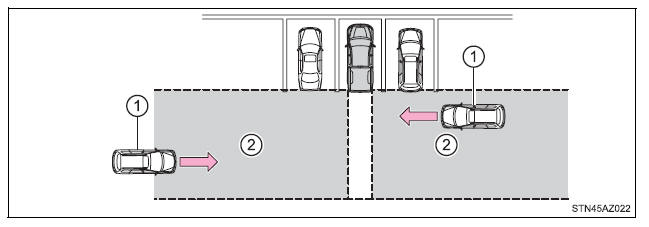
- Approaching vehicles
- Detection areas
| WARNING ■Cautions regarding the use of the
system
The driver is solely responsible for safe driving. Always
drive safely, taking
care to observe your surroundings.
The Rear Cross Traffic Alert function is only an assist and
is not a replacement
for careful driving. Driver must be careful when backing up,
even
when using Rear Cross Traffic Alert function. The driver's
own visual confirmation
of behind you and your vehicle is necessary and be sure
there are
no pedestrians, other vehicles, etc., before backing up.
Failure to do so
could cause death or serious injury.
According to conditions, the system may not function
correctly. Therefore
the driver's own visual confirmation of safety is necessary. |
The Rear Cross Traffic Alert function detection areas
The areas that vehicles can be detected in are outlined below.
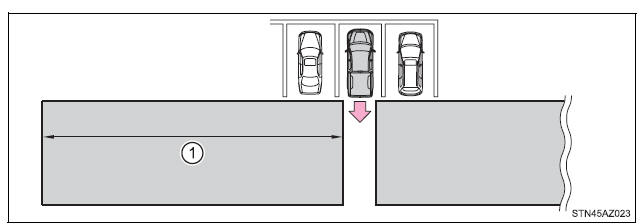
To give the driver a more consistent time to react, the buzzer can alert
for faster vehicles from farther away.
Example:

■The Rear Cross Traffic Alert function is operational when
- The RCTA function is set to on.
- The shift lever is in R.
- Vehicle speed is less than approximately 5 mph (8 km/h).
- Approaching vehicle speed is between approximately 5 mph (8
km/h) and
18 mph (28 km/h).
■Conditions under which the Rear Cross Traffic Alert function
will not
detect a vehicle
The Rear Cross Traffic Alert function is not designed to detect
the following
types of vehicles and/or objects.
- Small motorcycles, bicycles, pedestrians, etc.*
- Vehicles approaching from directly behind
- Guardrails, walls, signs, parked vehicles and similar
stationary objects*
- Vehicles moving away from your vehicle
- Vehicles approaching from the parking spaces next to your
vehicle*
- Vehicles backing up in the parking space next to your
vehicle*
*: Depending on conditions, detection of a vehicle and/or object
may occur.
■Conditions under which the Rear Cross Traffic Alert function
may not
function correctly
The Rear Cross Traffic Alert function may not detect vehicles
correctly in the
following conditions.
- When ice or mud, etc., is attached to the rear bumper
- During bad weather such as heavy rain, fog, snow, etc.
- When multiple vehicles approach continuously
- Shallow angle parking
- When a vehicle is approaching at high speed
- When parking on a steep incline, such as hills, a dip in the
road, etc.
- Directly after the RCTA function is set to on
- Directly after the engine is started with the RCTA function
is on
- When towing a trailer
- Vehicles that the sensors cannot detect
because of obstacles
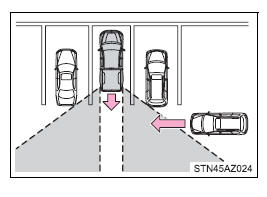
|